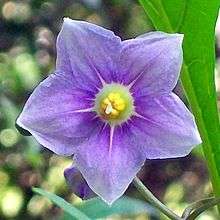Solanum aviculare
- "Kangaroo Apple" redirects here. This name is also used for related species of Solanum.
| Solanum aviculare | |
|---|---|
 | |
| Scientific classification | |
| Kingdom: | Plantae |
| (unranked): | Angiosperms |
| (unranked): | Eudicots |
| (unranked): | Asterids |
| Order: | Solanales |
| Family: | Solanaceae |
| Genus: | Solanum |
| Species: | S. aviculare |
| Binomial name | |
| Solanum aviculare G.Forst. | |
| Synonyms | |
|
Solanum baylisii Geras. | |
Solanum aviculare, commonly called poroporo (New Zealand), kangaroo apple (Australia), or New Zealand nightshade,[2] is a soft-wooded shrub native to New Zealand and the east coast of Australia.
It can grow up to 4 metres tall. The leaves are, 8–30 cm long, lobed or entire, with any lobes being 1–10 cm long.
Its hermaphroditic (having both male and female organs) flowers are white, mauve to blue-violet, 25–40 mm wide, and are followed by berries 10–15 mm wide that are poisonous while green, but edible once orange.
Uses
The leaves and unripe fruit of S. aviculare contain the toxic alkaloid solasodine. S.aviculare is cultivated in Russia and Hungary for the solasidine which is extracted and used as a base material for the production of steroid contraceptives.[3]
The plant is also used as a rootstock for grafting eggplant.
The orange berries are an edible form of bush tomato either fresh or dried.
Taxonomy and systematics
Solanum aviculare was first described by J. G. Forster in 1786, from a collection in New Zealand.[4]
S. aviculare has smaller, flowers (usually pale blue, sometimes dark purple, white or striped blue / white) with acute corolla lobes, it has smaller seeds (up to 2.0 mm long) and a different chromosome number (2n = 46) and is found on the Kermadec Islands, North Island, northern South Island and Chatham Islands of New Zealand, while S. laciniatum has much larger, rotate, darker purple flowers with broad, flared (ruffled) corolla lobes with rounded apices, larger seeds (2.0-3.0 mm long), and a different chromosome number (2n = 92). It is mostly found south of Auckland and is very common in the southern North Island, South, Stewart and Chatham Islands. Solanum laciniatum is the most commonly found species overseas where it is often incorrectly called S. aviculare.
In addition to this two varieties of S. aviculare have been named. S. aviculare var. albiflorum is a minor genetic sport of S. aviculare and is generally not regarded as distinct but S. aviculare var. latifolium has a different growth habit, much broader, usually entire leaves and larger flowers, and in New Zealand (where it is endemic) it is still accepted as distinct by many botanists.
- Solanum aviculare var. albiflorum Cheeseman
- Solanum aviculare var. latifolium G.T.S.Baylis
References
- ↑ Solanaceae Source (2006)
- ↑ "Solanum aviculare". Natural Resources Conservation Service PLANTS Database. USDA. Retrieved 17 November 2015.
- ↑ Low (1990): pp.210-211
- ↑ "Solanum aviculare G.Forst.". Australian Plant Name Index (APNI), IBIS database. Centre for Plant Biodiversity Research, Australian Government.
Footnotes
- Low, T. (1990): Bush Medicine, A Pharmacopoeia of Natural Remedies. Angus & Robertson. ISBN 0-207-16462-2
- Solanaceae Source (2006): Solanum sessiliflorum. Version of April 2006. Retrieved 2008-SEP-27.
External links
| Wikimedia Commons has media related to Solanum aviculare. |
- Plants of New Zealand S. aviculare